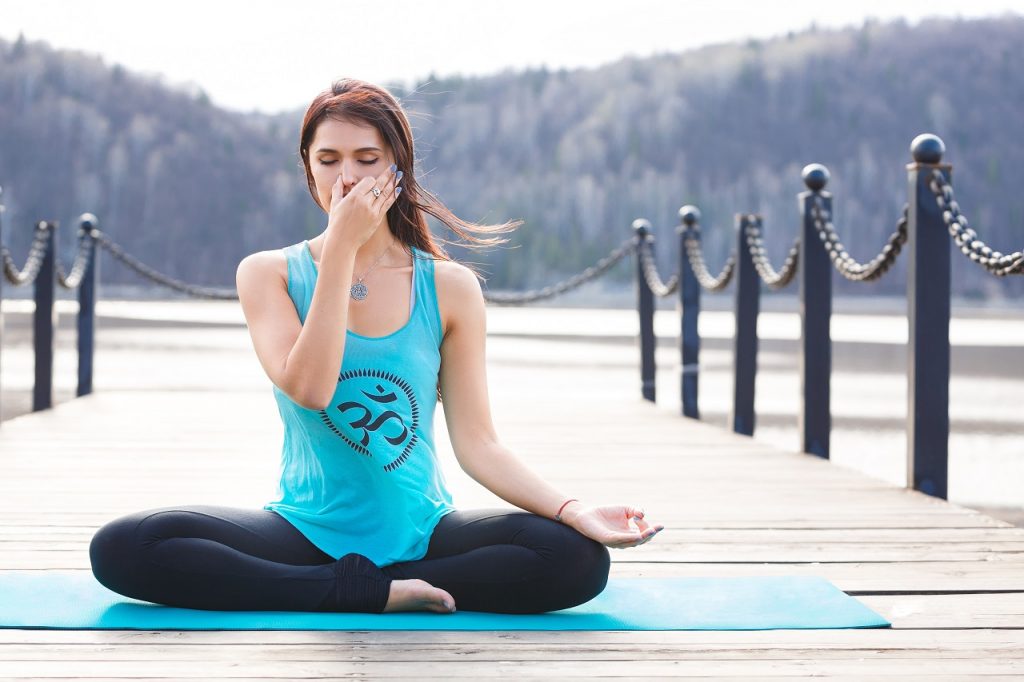
Pranayama is the yogic practice of breath control. It means the ability to expand our health by controlling the breath. There are various ways and positions to practice yogic breathing.
The combination of pranayama and meditation has positive effects in curing various problems like acidity, stress, anxiety, skin diseases, improved blood circulation, and managing lifestyle disorders such as thyroid, PCOS, controlling blood sugar and blood pressure.
We breathe daily, right? So what is pranayama? Why Pranayama?
Pranayama is slow, deep breathing, in a rhythm. The breathing that we do normally is not in rhythm and is non-harmonic. It is in pranayama that gets our mind and organs in sync. There are various pranayama practices which you can do daily.
1. Kapalbhati Pranayama
This is a famous pranayama practice also known as The Skull Shining Breathing Technique. Kapalbhati has physiological effects on cardiovascular, digestive and nervous systems.
Benefits of Kapalbhati Pranayama:
- It Generates heat in the system to help dissolve toxins and waste matter.
- Daily practice helps in adding luster to your face and you get glowing skin
- Improves digestion and can help alleviate gastrointestinal problems like acidity, indigestion and flatulence.
- Improves the function of kidneys and liver as it provides a gentle massage to the organs.
- If practiced daily helps in reducing belly fat.
- Kapalbhati helps reduce stress in the eyes, thus reduces dark circles around the eyes.
- It triggers your abdominal region, so it’s beneficial for diabetic patients.
- It improves the blood circulation problem in whole body parts.
2. Anulom Vilom
Also known as Alternate nostril breathing, it has various benefits for the body internally and externally. Oxygen is pure and required by the body for every single process to take place and therefore, it is vital for us to breath right and Anulom Vilom serves the purpose. It is the best way of balancing the Tri Dosas (Tri means “three” and the meaning of dosas is impurities) in our body i.e. Vaat, Pitta and Kaffa. All three are the cause of all diseases. So, it is important to balance them. Our body gets ill when Tri Dosas are not in harmony.
Benefits of Anulom Vilom Pranayama
- It can provide some relief from mental health problems like Depression, Anxiety, Stress, Tension, etc.
- Improves the working of the lungs, beneficial for most respiratory problems like (Bronchitis, Asthma), etc.
- Best breathing technique for boosting your memory – makes your brain sharper, increases concentration and gathers focus.
- Improves your immune system, so it can cure general issues like cough & cold.
- Alternate nostril breathing is an ideal breathing technique for maintaining your heart healthy.
3. Sheetali Pranayama
The meaning of the word “Sheetali” is cooling down. This pranayama practice is a process to cool your body down. It gives the feeling of coldness by decreasing the body temperature, thereby having a positive impact on our nervous system and endocrine glands. Extremely helpful during the summer season.
Benefits of Sheetali Pranayama
- It is useful in managing disorders related to tongue, mouth and throat.
- It is very beneficial in treating diseases of the spleen.
- Helpful in fever by cooling the system down.
- Controls and manages high blood pressure.
- It purifies the blood.
- Improves sleep quality and is best for fighting Insomnia.
- It calms the mind, as it is an effective stress buster. Once our mind is calm, we can easily deal with negative emotions like anger and anxiety.
- Effective in hyperacidity. Excellent for people who have GERD and face issues with acidity and indigestion.
There is another breathing practice similar to Sheetali, known as Sheetkari pranayama.
Both are similar, the only difference is the way of breathing. In Sheetali, we breathe in by folding the tongue and breathe out from the nose. In Sheetkari, we inhale through the teeth and exhale from the nose.
Benefits of Sheetkari Pranayama
- Effective against dental problems like bad breath, bleeding gums and pyorrhea.
- Balances body temperature.
- Calms the mind, reduces emotional excitation and mental tension.
- Can help you manage depression, anxiety and panic attacks.
As a yoga instructor, I get these questions a lot of time: What is the best time to do pranayama? Generally, morning is the best time for a breathing exercise as it helps us activate our organs. Plus, on an empty stomach, we achieve optimum benefits. To know why morning yoga is beneficial, you can have a look at my previous article: https://goqii.com/blog/benefits-of-practicing-morning-yoga-at-home.
We hope this article helps you! For more on yoga, check out Healthy Reads. You can also get tips and learn more about yoga and pranayama from experts by subscribing for GOQii’s Personalised Health Coaching here:
#BeTheForce




I have heard of the Pranayama To Detoxify method. Indeed it will be beautiful and healthy there. But it will be tiring at first although the way to practice is quite easy.
When practicing Pranayama, you can also practice yoga and do exercise to have a more supple body.